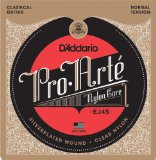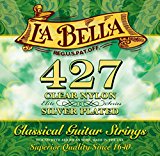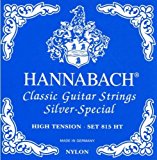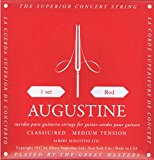The Best Classical Guitar Strings
We may also earn commissions on purchases from other retail websites.

Last Updated Jul-26-2018.
There was no need for a big overhaul of our article on the best classical guitar strings, although we did replace the LaBella 2001M Classic set with the popular D’Addario EJ45FF ProArte Carbon strings. We also added a few new answers to your most popular questions.
If you have read our in-depth guide on how to find the best guitar strings you’ll know how important good strings are to the overall tone and playability of every style of guitar – from electric to bass.
And this certainly rings true with the classical nylon-stringed guitar, because the tone and feel of a great classical instrument can easily be ruined with a bad set of strings. Thankfully the reverse is also true – even if you own a low-quality classical guitar, you can still squeeze a good sound out of it if the strings are high-quality and fit your style.So after you’ve found your perfect classical guitar, the next task is to find suitable classical strings. And this page will go a long way to helping you do that. We have prepared a short chart highlighting some of the best-selling strings available today, as well as a guide to buying the best classical strings for you, and some short reviews on five of the most popular string brands on the market.
6 Recommended Nylon Strings:
| Image | Guitar Strings / Rating | Summary | Check Price |
|---|---|---|---|
+ -  | D'Addario EJ45 Pro-Arte Total of 4.90/5 | One of the best-selling classical strings in the world – well-balanced with a normal tension. | |
+ -  | Savarez 540R Alliance Total of 4.80/5 | A popular normal-tension string from Savarez – loud, bright, and clear. | |
+ -  | LaBella 2001M Classic Total of 4.70/5 | An exceptional medium-tension string especially designed for flamenco players. | |
+ -  | Hannabach Classical 815-HT Total of 4.70/5 | Hannabach’s best-selling string series, with nylon trebles and silver-special coated basses. | |
+ -  | Augustine Classic-Red Total of 4.70/5 | High-quality Augustine string, with a medium tension and silver-plated copper-wound basses. | |
+ -  | Ernie Ball Earthwood Folk Total of 4.60/5 | Best-selling D’Addario acoustic string – medium gauge (.013-.056) made with phosphor bronze. |
D’Addario
 It’s no surprise that one of the most celebrated string makers in the world are one of the leaders when it comes to classical guitar strings. D’Addario have been producing strings since the 1930’s, and have a long history when it comes to classical guitar strings, with their products played by some of the best classical artists around the world. The American manufacturer’s selection of classical strings is fantastic, varying in a range of classic and contemporary treble, bass, and core materials, tensions, construction methods, and coatings. Their EJ45 Pro-Arte in particular are currently one of the best-selling classical strings on the market – affordable silver-plated copper-wound nylon strings with a normal tension for all styles of play, offering a warm, but well-balanced tone with plenty of projection. Their EXP45 series are similar, but offer a longer-lasting tone, thanks to the special micro-fine coating applied to the string. If you prefer a brighter, more contemporary tone, D’Addario’s Carbon EJ45FF series is worth considering, with fluorocarbon strings offering a bright, vibrant and projecting sound.
It’s no surprise that one of the most celebrated string makers in the world are one of the leaders when it comes to classical guitar strings. D’Addario have been producing strings since the 1930’s, and have a long history when it comes to classical guitar strings, with their products played by some of the best classical artists around the world. The American manufacturer’s selection of classical strings is fantastic, varying in a range of classic and contemporary treble, bass, and core materials, tensions, construction methods, and coatings. Their EJ45 Pro-Arte in particular are currently one of the best-selling classical strings on the market – affordable silver-plated copper-wound nylon strings with a normal tension for all styles of play, offering a warm, but well-balanced tone with plenty of projection. Their EXP45 series are similar, but offer a longer-lasting tone, thanks to the special micro-fine coating applied to the string. If you prefer a brighter, more contemporary tone, D’Addario’s Carbon EJ45FF series is worth considering, with fluorocarbon strings offering a bright, vibrant and projecting sound.
Savarez
 Having been in business for nearly 250 years – founded in Paris in 1770 – it’s no wonder Savarez are so popular, with a huge roster of international professional artists using their classical guitar strings including Alvaro Pierri, Igor Miagtchenkov, Eva Fampas, and Heike Matthiesen. One of their best-selling and highest quality string sets is the 540R Alliance, which feature silver-plated wound bass strings, with carbon trebles and a normal tension. Even though they are more expensive than standard strings, they show excellent quality and are renown for being loud, bright and clear. If you’re looking for a more affordable option, Savarez offer their 520R traditional strings, with silver-plated basses and rectified nylon trebles in a high tension. However their full range is very extensive, catering for all styles of classical guitar with a catalog of various tensions and materials. Another popular set is their 500CJ Cristal Corum, which come in normal, high, and mixed tensions, and feature focused, clear Cristal nylon trebles with flexible Corum bass strings, with a high dynamic range.
Having been in business for nearly 250 years – founded in Paris in 1770 – it’s no wonder Savarez are so popular, with a huge roster of international professional artists using their classical guitar strings including Alvaro Pierri, Igor Miagtchenkov, Eva Fampas, and Heike Matthiesen. One of their best-selling and highest quality string sets is the 540R Alliance, which feature silver-plated wound bass strings, with carbon trebles and a normal tension. Even though they are more expensive than standard strings, they show excellent quality and are renown for being loud, bright and clear. If you’re looking for a more affordable option, Savarez offer their 520R traditional strings, with silver-plated basses and rectified nylon trebles in a high tension. However their full range is very extensive, catering for all styles of classical guitar with a catalog of various tensions and materials. Another popular set is their 500CJ Cristal Corum, which come in normal, high, and mixed tensions, and feature focused, clear Cristal nylon trebles with flexible Corum bass strings, with a high dynamic range.
LaBella
 Although the Mari family registered the business in 1920, the string-making roots of LaBella stretches all the way back to 1640! Today, LaBella remains a leading manufacturer of classical guitar strings, providing their quality product to a huge list of top-selling professional classical artists in all genres – from flamenco to folk – including Willie Nelson, Bucky Pizzarelli, Andrew York, and The Gipsy Kings. As part of their Elite series, their 427 Elite are popular medium-tension strings, with clear nylon trebles and silver-plated wound bass strings, that combine for a warm tone and smooth playability. If you are looking for a stand-out flamenco string, LaBella’s 820 Red Nylon are superior in their category, with red nylon trebles and silver-plated wound bass strings, designed especially for flamenco players, with a well-balanced, warm and rich tone. If folk music is more your style, their 830 Folksinger strings should be on your list, and have even been endorsed by Willie Nelson – with mellow but big-projecting black nylon treble strings and 80/20 brass basses, with ball ends for easy string changing.
Although the Mari family registered the business in 1920, the string-making roots of LaBella stretches all the way back to 1640! Today, LaBella remains a leading manufacturer of classical guitar strings, providing their quality product to a huge list of top-selling professional classical artists in all genres – from flamenco to folk – including Willie Nelson, Bucky Pizzarelli, Andrew York, and The Gipsy Kings. As part of their Elite series, their 427 Elite are popular medium-tension strings, with clear nylon trebles and silver-plated wound bass strings, that combine for a warm tone and smooth playability. If you are looking for a stand-out flamenco string, LaBella’s 820 Red Nylon are superior in their category, with red nylon trebles and silver-plated wound bass strings, designed especially for flamenco players, with a well-balanced, warm and rich tone. If folk music is more your style, their 830 Folksinger strings should be on your list, and have even been endorsed by Willie Nelson – with mellow but big-projecting black nylon treble strings and 80/20 brass basses, with ball ends for easy string changing.
Hannabach
 Hannabach’s history takes us back to Eger, Bohemia, where Anton Hannabach founded his company in 1869. The German brand have produced strings for thousands of classical guitarists in their time and still do to this day, with a big range of advanced strings that suit all styles of classical guitar music and experience levels. Hannabach are also endorsed by a long list of modern classical artists, including Mislav Režić, Rico Stover, Xingye Li, and the Melbourne Guitar Quartet. Hannabach’s 815 Silver Special is their best-selling string series, and it’s easy to see why – the multi-purpose set (which comes in tensions from super high to super low) features nylon precision-round trebles, with silver-special coated basses to deliver a consistent, superlative sound suitable for beginners to professional recording artists. Another very popular string in Hannabach’s range is the 725 Goldin series, which – while expensive in comparison to others on this list – offer excellent quality, with medium-tension golden yellow super carbon fiber trebles and golden nickel-wound basses, offering a soft, warm, and long-lasting sound.
Hannabach’s history takes us back to Eger, Bohemia, where Anton Hannabach founded his company in 1869. The German brand have produced strings for thousands of classical guitarists in their time and still do to this day, with a big range of advanced strings that suit all styles of classical guitar music and experience levels. Hannabach are also endorsed by a long list of modern classical artists, including Mislav Režić, Rico Stover, Xingye Li, and the Melbourne Guitar Quartet. Hannabach’s 815 Silver Special is their best-selling string series, and it’s easy to see why – the multi-purpose set (which comes in tensions from super high to super low) features nylon precision-round trebles, with silver-special coated basses to deliver a consistent, superlative sound suitable for beginners to professional recording artists. Another very popular string in Hannabach’s range is the 725 Goldin series, which – while expensive in comparison to others on this list – offer excellent quality, with medium-tension golden yellow super carbon fiber trebles and golden nickel-wound basses, offering a soft, warm, and long-lasting sound.
Augustine
 Established in 1947, Augustine are one of the newer brands on this list, but their strings stand up with the best of them. Augustine are also particularly notable for creating the very first nylon string in 1948, as an alternative to animal intestine and silk. They are best known for their classical strings which come in several varieties, catering for all styles of nylon-stringed music. The trio that build up their range are the Classic, Imperial, and Regal series, with simple color coding to differentiate between the tensions – blue for high tension, black for light tension, and red and gold for medium tension (red features silver-plated copper-wound basses, while the gold set has gold-plated copper-wound basses). Their Classic Red medium-tension strings are one of their biggest sellers, and offer players sweet-sounding trebles with warm basses. Augustine’s Regal Blue high-tension strings are also popular, with a powerful, clear bass tone. As you would probably expect, many highly-acclaimed classical guitar virtuosos use Augustine for their recordings and performances, including Jorge Caballero, Scott Borg, Paulo Martelli, Gen Matsuda, and Eduardo Fernández.
Established in 1947, Augustine are one of the newer brands on this list, but their strings stand up with the best of them. Augustine are also particularly notable for creating the very first nylon string in 1948, as an alternative to animal intestine and silk. They are best known for their classical strings which come in several varieties, catering for all styles of nylon-stringed music. The trio that build up their range are the Classic, Imperial, and Regal series, with simple color coding to differentiate between the tensions – blue for high tension, black for light tension, and red and gold for medium tension (red features silver-plated copper-wound basses, while the gold set has gold-plated copper-wound basses). Their Classic Red medium-tension strings are one of their biggest sellers, and offer players sweet-sounding trebles with warm basses. Augustine’s Regal Blue high-tension strings are also popular, with a powerful, clear bass tone. As you would probably expect, many highly-acclaimed classical guitar virtuosos use Augustine for their recordings and performances, including Jorge Caballero, Scott Borg, Paulo Martelli, Gen Matsuda, and Eduardo Fernández.
While this list covers five popular classical guitar string manufacturers, there are several other brands that are worth considering, who offer a plethora of strings featuring different materials, construction methods, and prices to suit your budget – these include Martin, Ernie Ball, Jim Dunlop, and Royal Classics, among others.
Guide to Buying The Nylon Strings You Need
If you have navigated to this page, chances are you are aware of the difference between a classical nylon-stringed guitar and a steel-string acoustic, and you’ll also know that the strings are not interchangeable – using steel on a classical guitar will usually result in a damaged instrument!
This page is dedicated solely to nylon-stringed guitars – you can check out our separate steel-string acoustics page for a guide on steel strings.
Nylon strings are well-known for producing the warm, smooth, mellow tones needed for classical, flamenco, bossa nova, and folk music. They also tend to be popular with beginners as they are slightly easier on the fingers when first starting out.
Tension
The first thing to consider when it comes to buying strings for your classical guitar is the tension, which will usually be listed as low (or light), normal (or medium), and high (or hard). However, be aware that there is no industry standard, so one manufacturer’s normal may differ from another. It will be a case of trial and error – try a few different brands and tensions to find one that works for you.
To roughly distinguish between the tensions, low/light tension strings are typically easier to fret so are perfect for beginners as well classical guitars with a higher action as you don’t need to apply as much pressure to sound the note. The main disadvantage with low-tension strings is that they don’t have the projection or volume you’d find with higher tension sets.
High/hard tension strings, on the other hand, are naturally better when it comes to louder volume and bold projection, and work very well for rhythmic playing styles such as flamenco. However, these are traditionally harder to fret, especially on guitars with higher action.
If you are a beginner, or not sure what suits your style, a set of normal/medium tension strings would be a good choice as they are good all-rounders. You can also find hybrid packs, which offer treble and bass strings in different tensions, giving you extra versatility.
With other styles of guitar, the gauge of the string can be an important factor, but with classical strings there tends to be a standard ‘normal’ gauge of around .028-.043. This number will vary slightly in manufacturer, but not as much as in electric guitar strings, steel-string acoustic strings, or strings for metal.
Materials
The next important aspect of a classical string to consider is the material. This is where classical guitars have similarities to other strings, in that the strings can be made from several different materials that all affect the tone and feel of the instrument.
The materials typically used for classical guitar strings are split between the bass and treble strings. More often than not, treble strings tend to use a variation of nylon – which gives the classic rich and mellow sound – or rectified nylon, which are precision ground and sound even smoother and more well-rounded. Black nylon is another choice for the treble strings, and is slightly warmer and mellower than plain nylon, while the more modern titanium is preferred by classical guitarists looking for a brighter sound.
As for the bass strings of a classical guitar, 80/20 bronze (also known as ‘brass’ or ‘gold’ by some brands) is a favorite with many guitarists, with good brightness and projection. Equally popular is silver-plated copper (also known as ‘silver’) windings, that offer a warm tone thanks to the copper, while the silver plating ensures a smooth feel.
When it comes to the core of the bass strings, these are typically either multifilament nylon for a classic and consistent tone, or a contemporary multifilament composite, which gives increased tuning stability.
Coatings
Finally, some brands offer special coatings on their strings, such as D’Addario’s EXP range, that can help protect the materials from oil, moisture, dirt, and rust – prolonging the lifespan and tone of the strings. Although coated strings are usually more expensive to buy, they can last up to five times longer, working out more cost-effective in the long run.
What are the Best Classical Guitar Strings for Beginners?
When it comes to string brands, there is no one brand that caters better for beginners. However, if you are just starting out on the classical guitar, we recommend a set of low/light tension strings, as they can be easier to fret and, therefore, more comfortable for beginner fingers.
If you prefer a little more volume to your sound, a set of normal/medium tension strings will also be a good choice for beginners, and don’t require that much more effort to play.
When is it Time to Change Guitar Strings?
While there may not be a universally agreed amount of time to leave between string changes, it is worth changing the strings on your classical guitar once every three months or 100 hours of playing (whichever comes first).
You may need to change them more often if you play your guitar frequently. Take a look at the strings and you can tell whether a change is needed – do they look corroded or discolored? Are they dry or gritty to play with? Does your tone seem a little dull or lifeless? Is your guitar falling out of tune too often? If you answered yes to any of these questions, chances are the strings need a change.
What Does ‘Warm’ and ‘Bright’ Mean When Talking About Tone?
This is an age-old argument between guitarists and one in which both nobody and everybody is right! This is because tonal descriptions such as ‘warm’ and ‘bright’ are subjective – each person will define tone slightly differently.
However, most guitarists will agree that bright shares some characteristics, in that it is crisp, sharp, sparkly or biting, and is associated with trebly sounds in particular. For classical guitars, a set of carbon or titanium strings will produce brighter tones than traditional nylon.
In comparison, warm tones have connotations of smooth, thick, full, dark and creamy, and feel a bit more bass-heavy. Traditional nylon or black nylon strings, particularly with silver-plated copper bass strings, are among the warmest classical strings you will find.
The Final Word
You may be a beginner buying their first set of replacement strings, or a seasoned pro looking for something a little different – whatever category you fit in, you’ll always benefit from trying something different. As you’ve seen, tensions, materials and construction methods can all change the way a string performs and sounds, and the current string you play with may not be the best one for you. So keep trying and testing strings, and you will eventually find something that sounds and feels perfect.
If you are a beginner, you may need help changing your strings – which can be a complicated process, especially when it comes to fiddly methods used with nylon strings. Check out the informative video from Cordoba below, providing step-by-step instructions on how to change and tie your new strings.
Good luck and happy string shopping!







Stan Godlovitch says
Is there any research on the relative durability of different makes; e.g., the amount of consistency in tonal quality before a string – notably the 4th – goes dead? It’s obvious that a string’s being pressed over a fret will wear the string out. The trebles will flatten at such points and lose their clarity of pitch. The basses will have their wire wrappings increasingly damaged by the frets and eventually go dull and even fuzzy. There might be differences in the different makes regarding the ability of the string to retain its new sound given the effect of being damaged by the fret. Has anyone researched this factor? It could be done reasonably carefully but would take a lot of playing of the same pieces by the same players using different makes.
Wayne says
Thanks for the excellent article write-up on classical guitar strings. Really well done.
Roni says
I have a very very small nylon string guitar. Would like it to sound the best it can ever be. Gadge? Tension? What should I be looking for? Thanks.
Daniel Zwickel ben Avram says
You fail to mention te La Bella La Bella 413P Studio Recording Strings. With polished wound basses, they are the world’s first noise-free classical guitar strings — no harsh squeaking when shifting positions or playing a glissando. They are bright and durable, and I have used them for decades as a strolling singer-guitarist. I have not found their equal, at least for my purposes
Chris says
Thanks Daniel, that is a good call – I think we will add them in on our next article refresh!
Denis Karsten says
Great article with many thanks … have you tried Tomastick strings very pricy but they indicate that they stabilize quickly and really reduce string squeak. True?